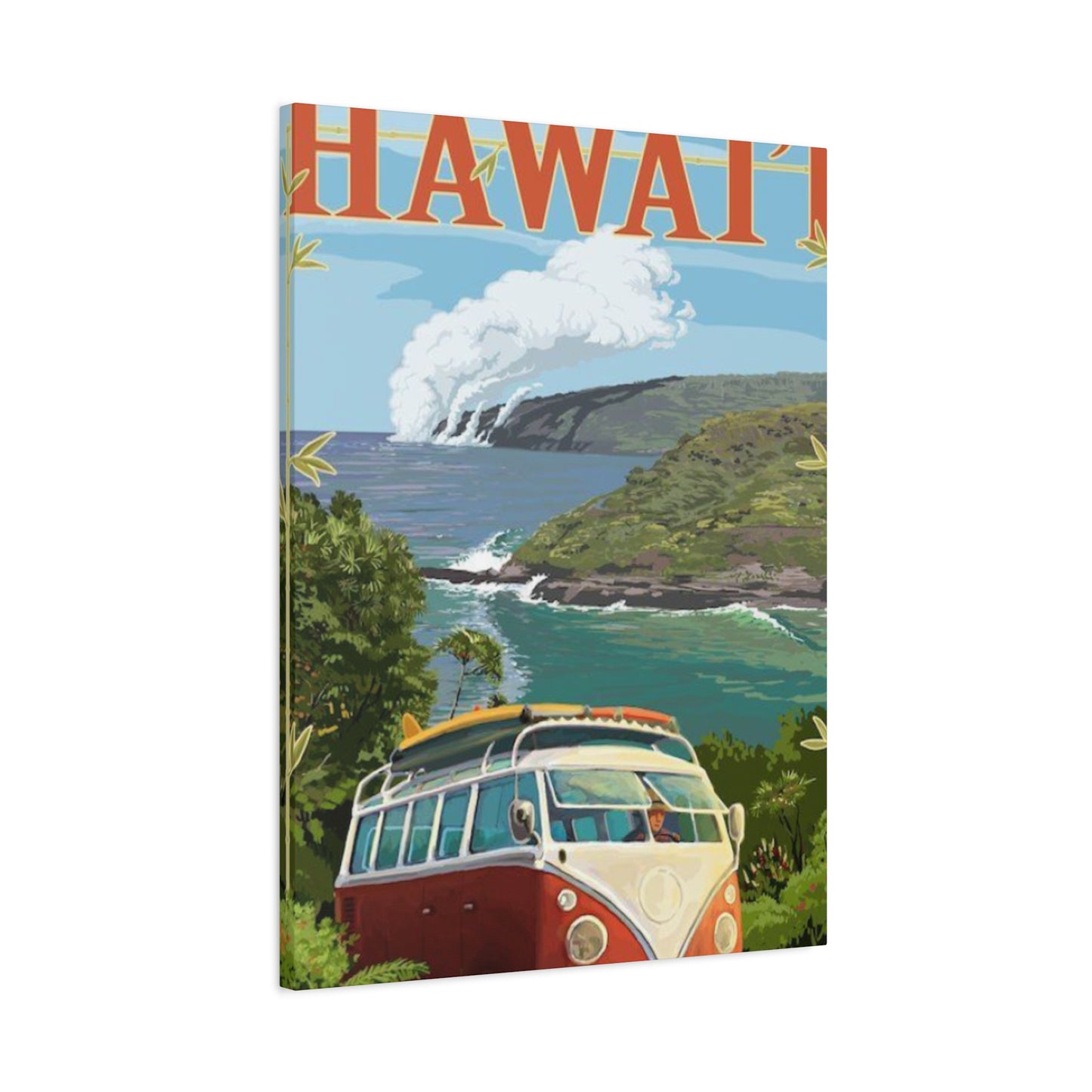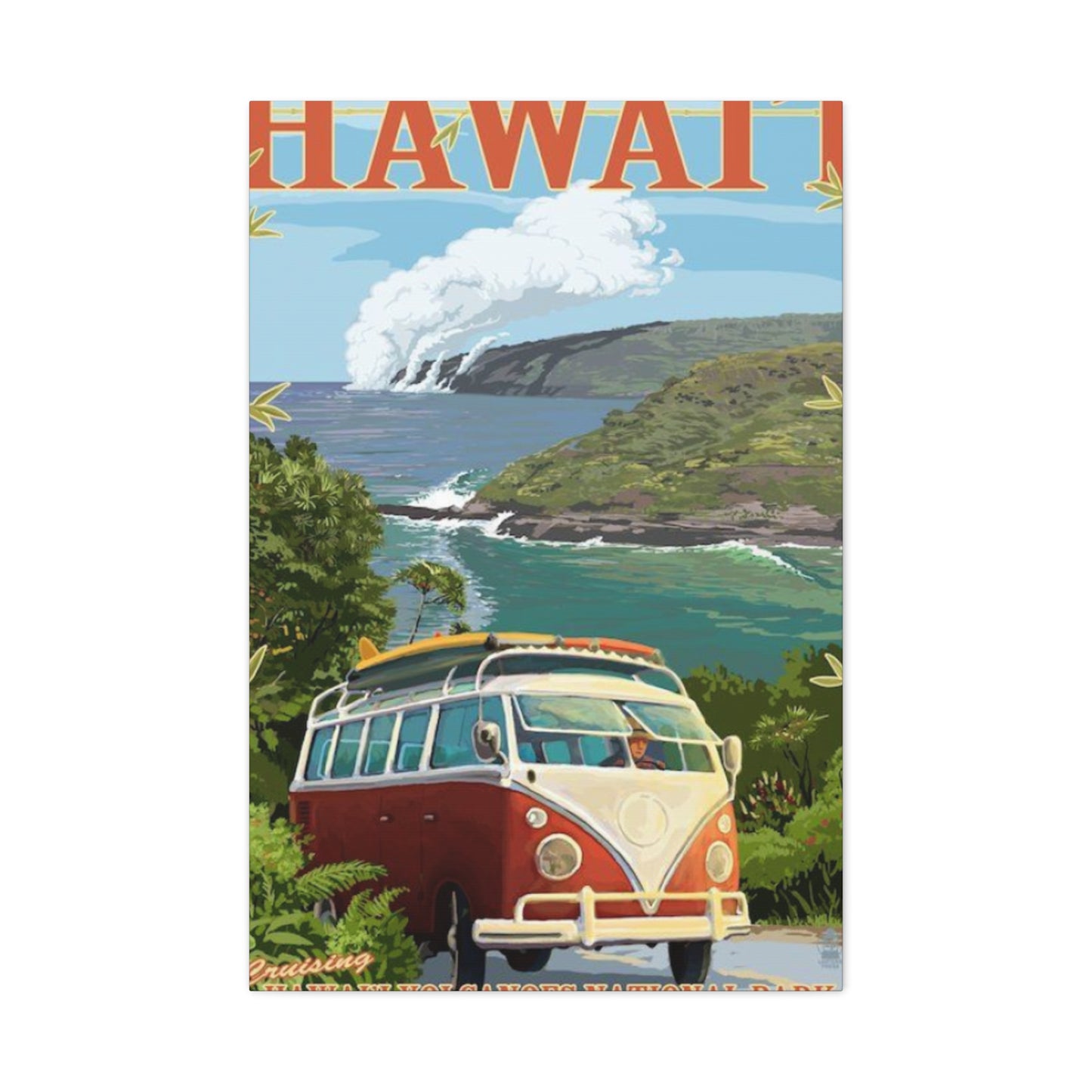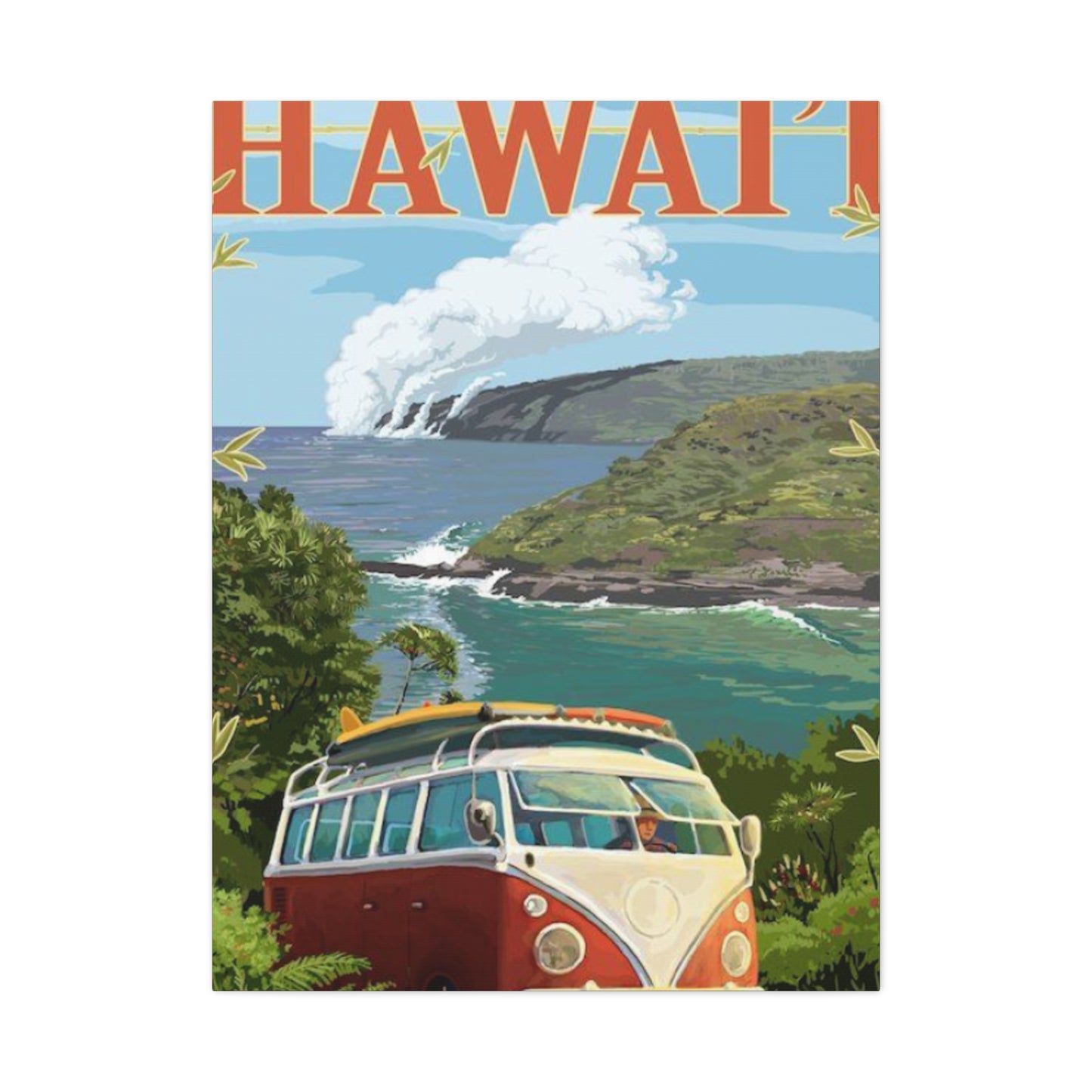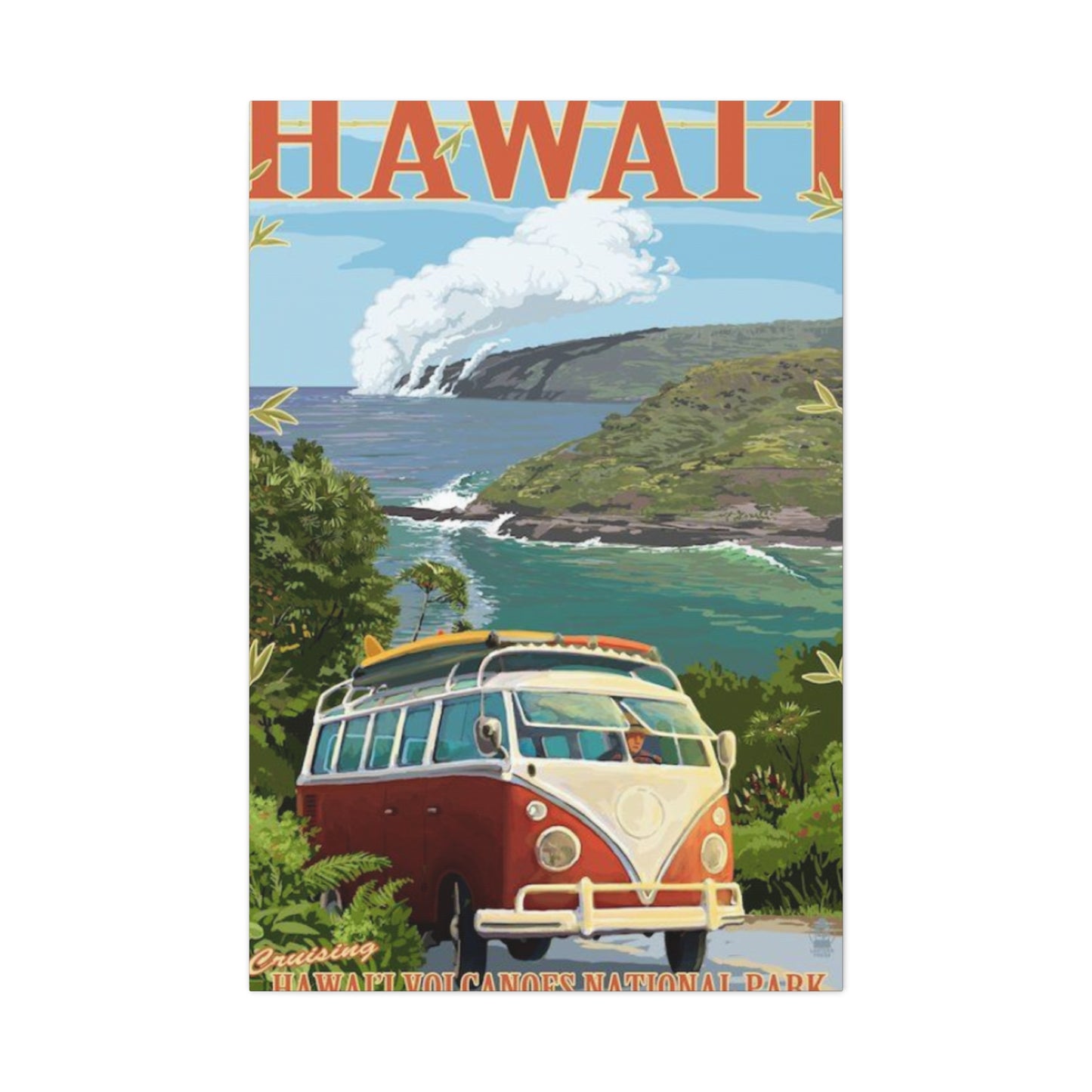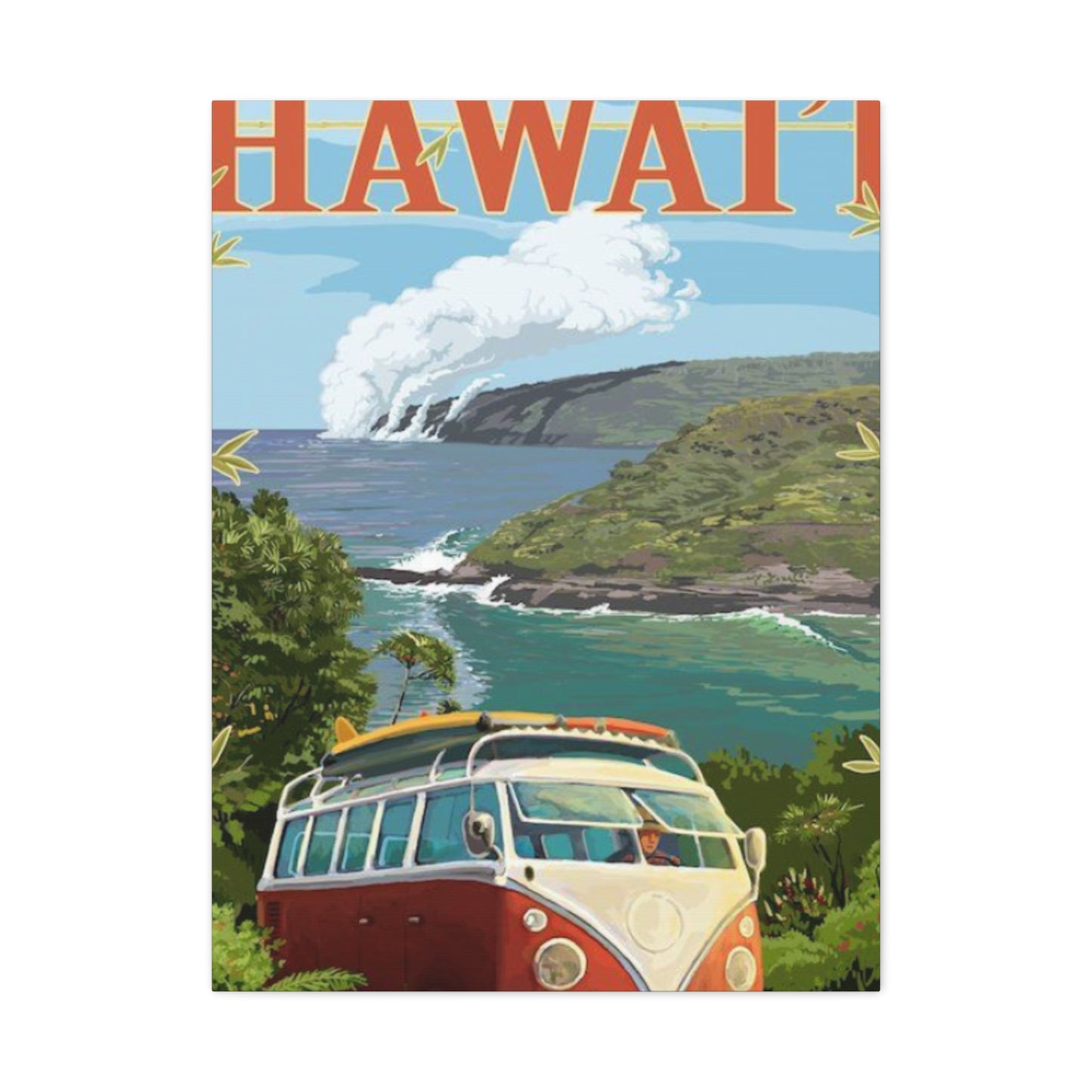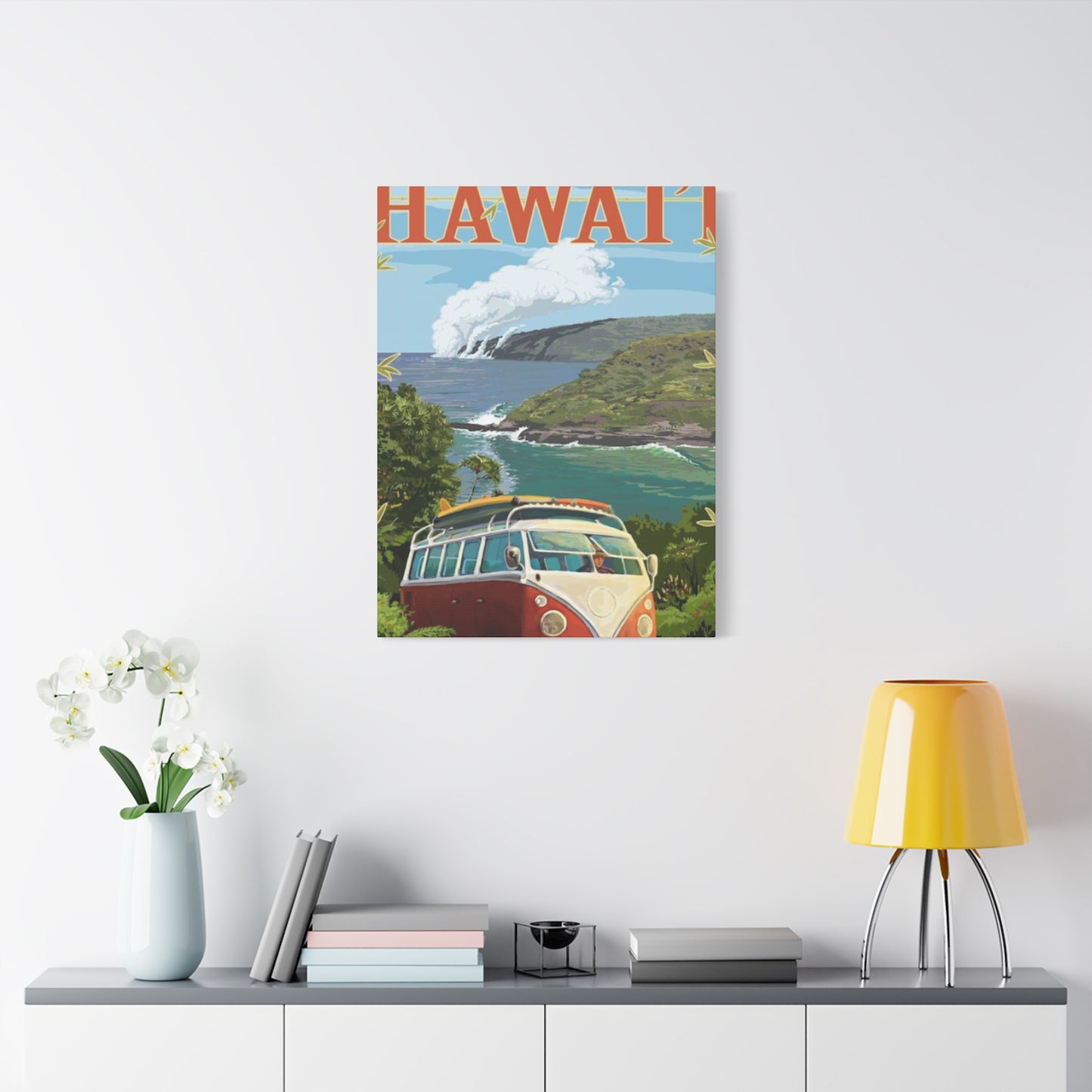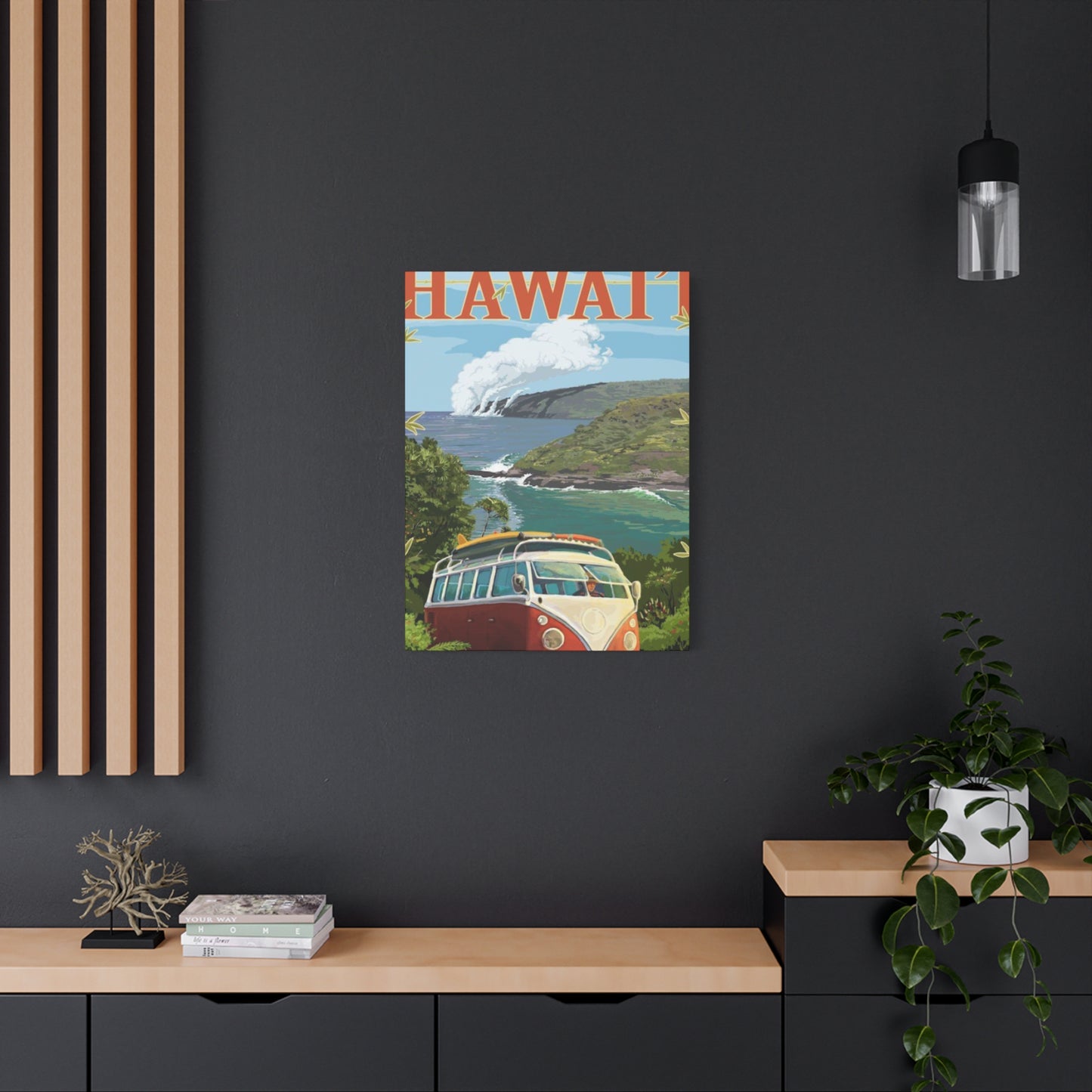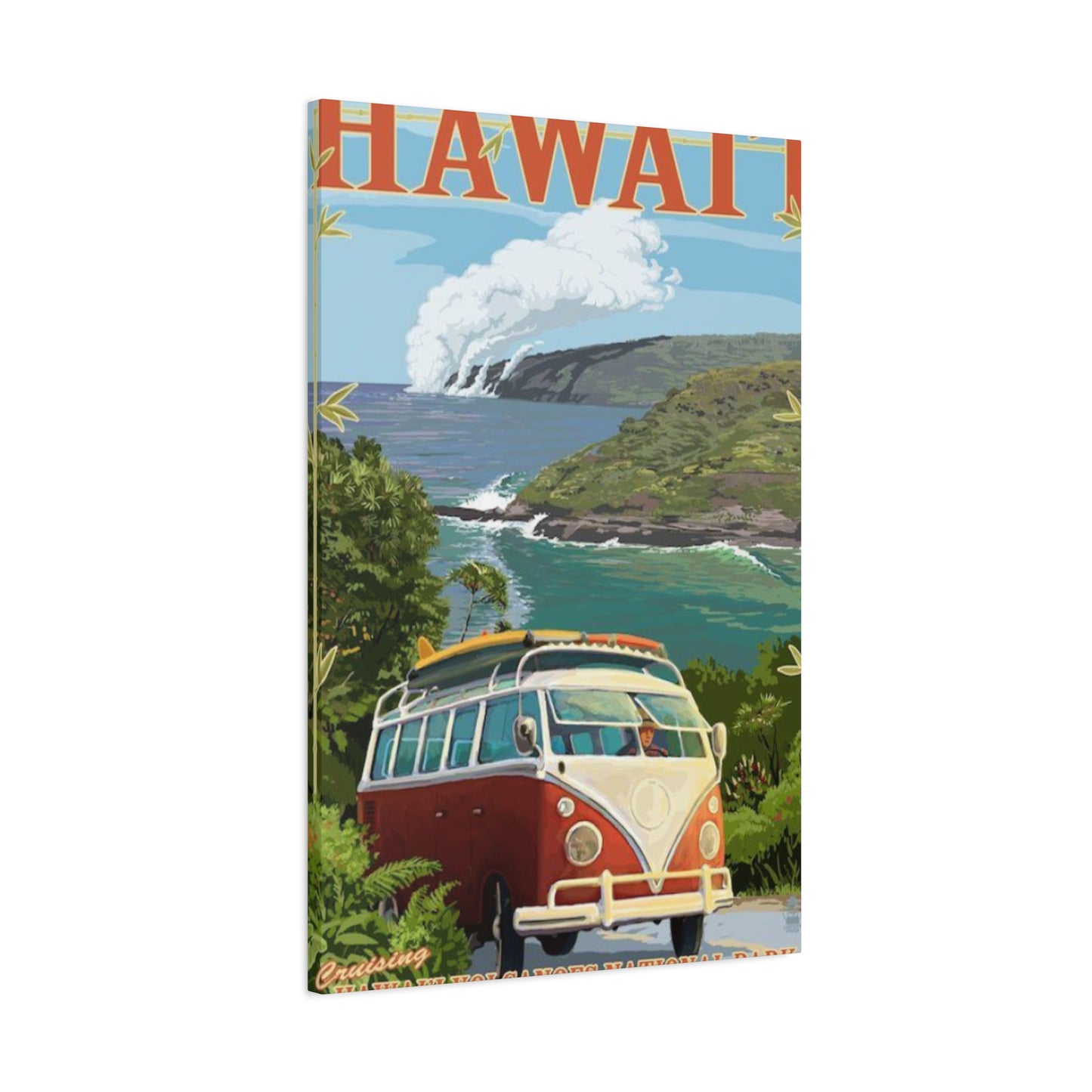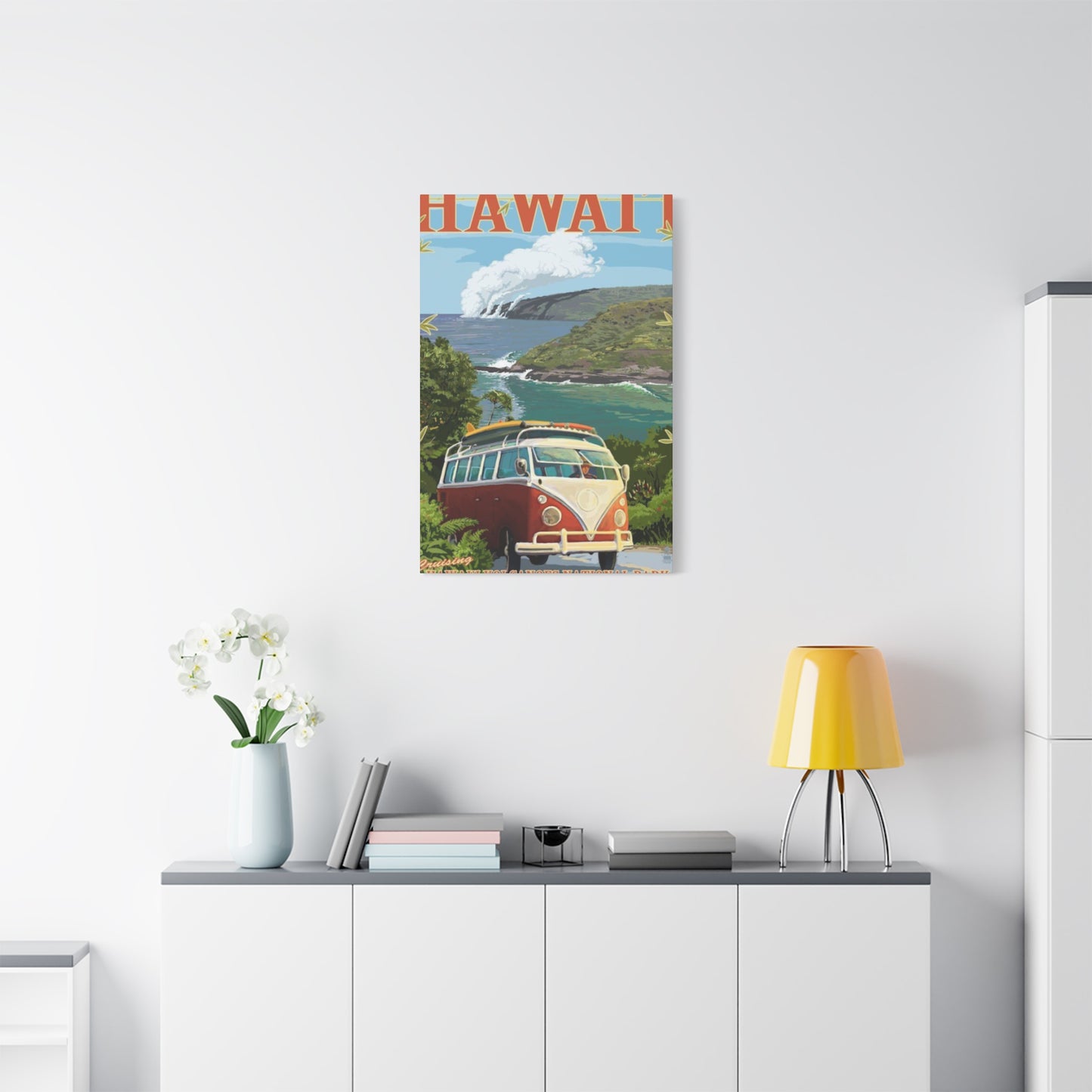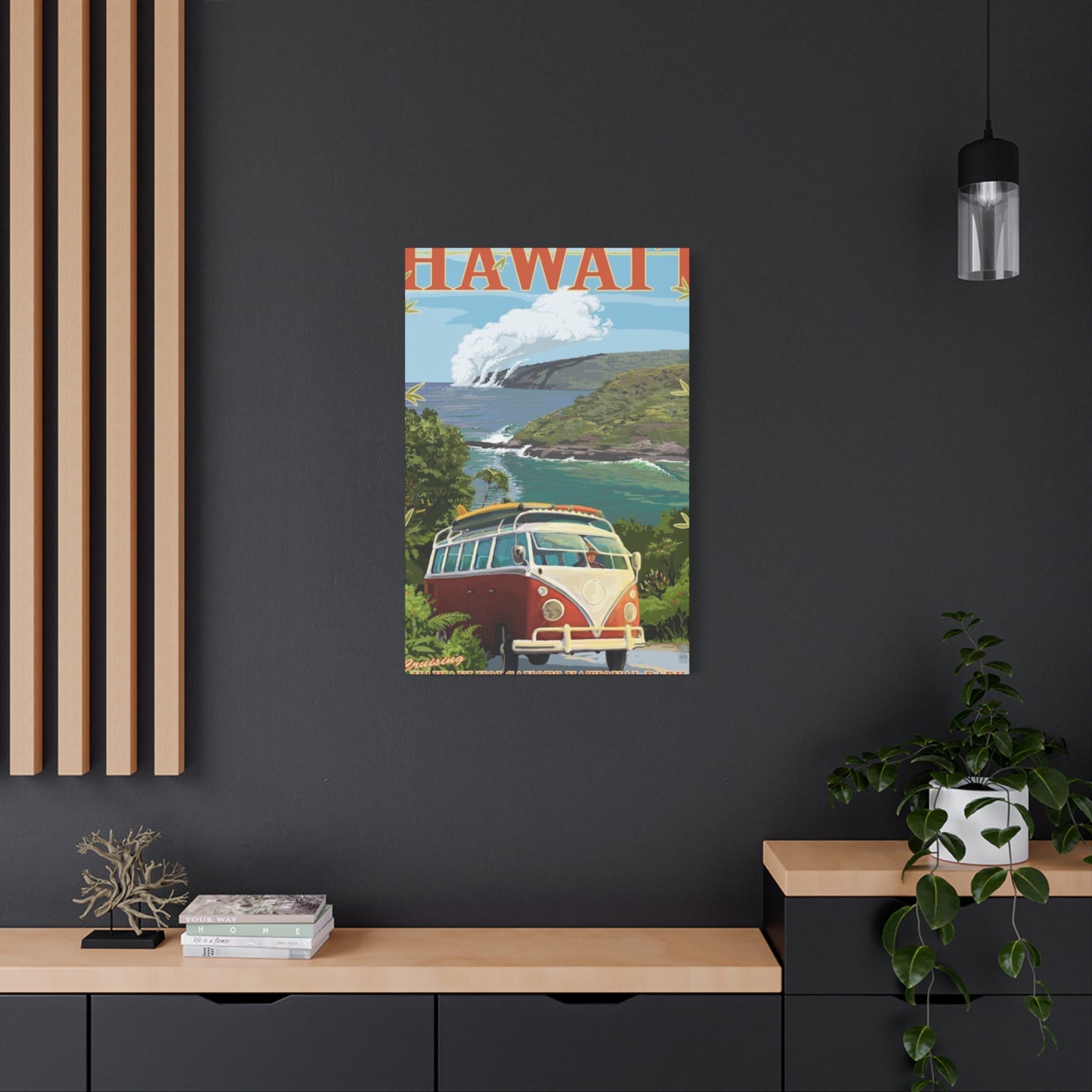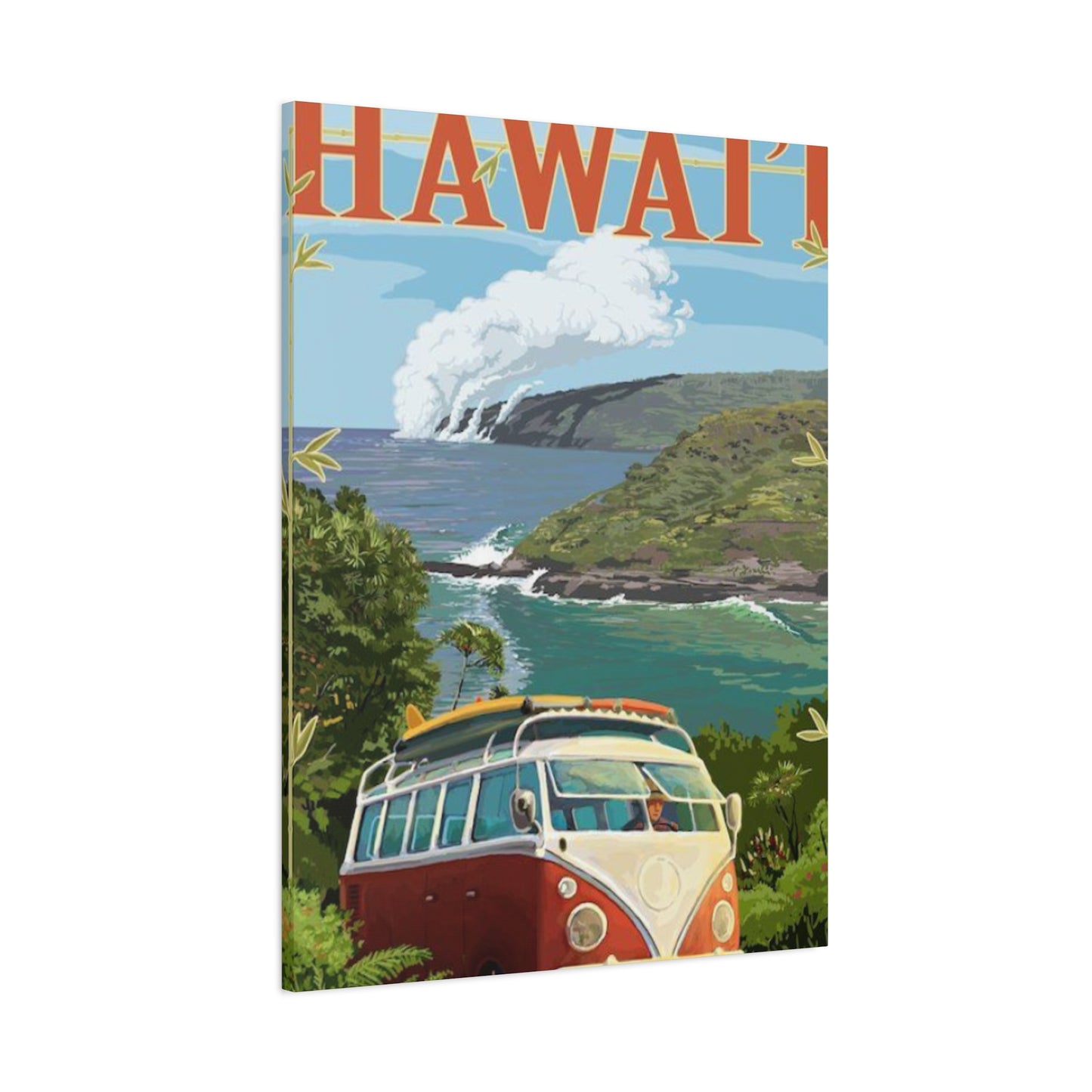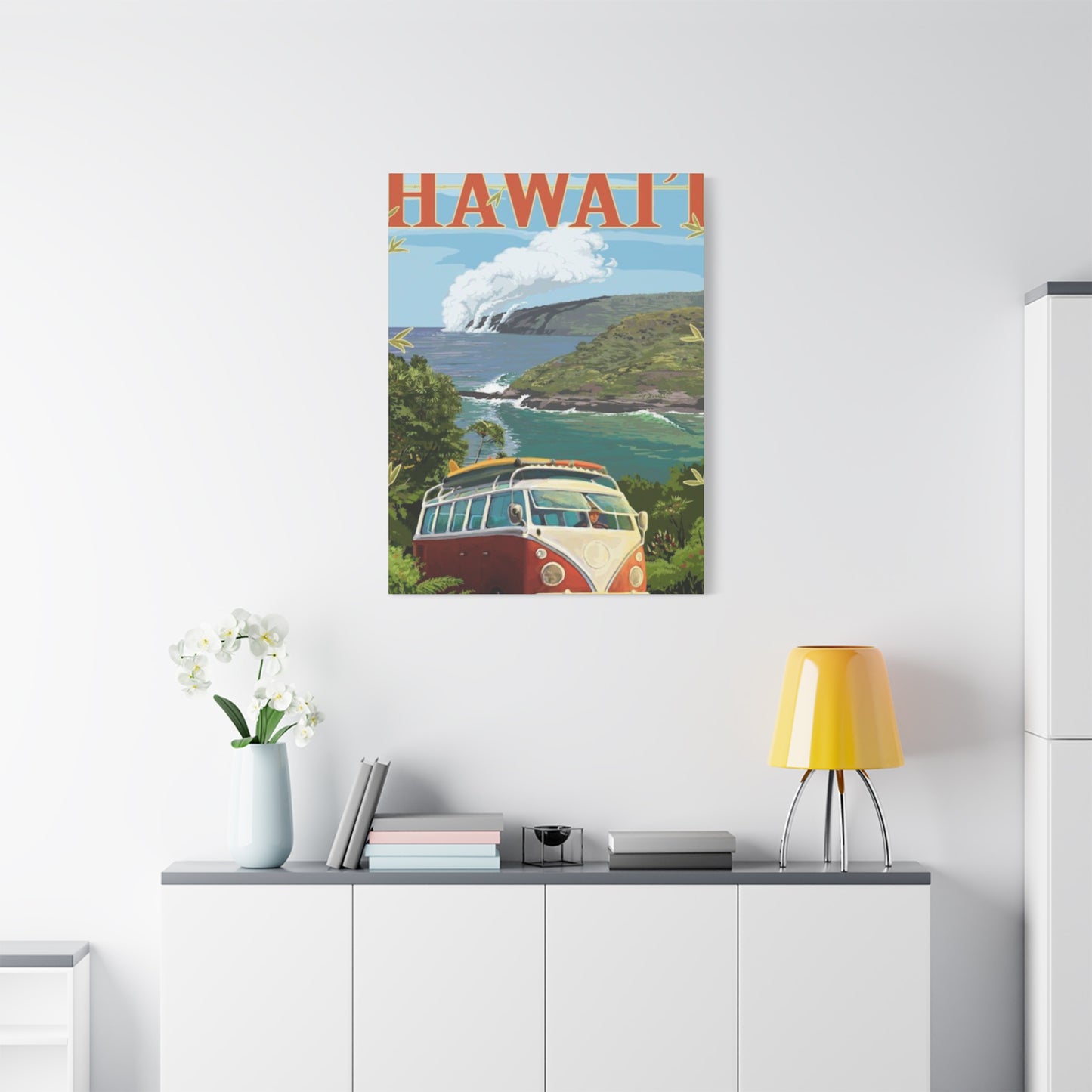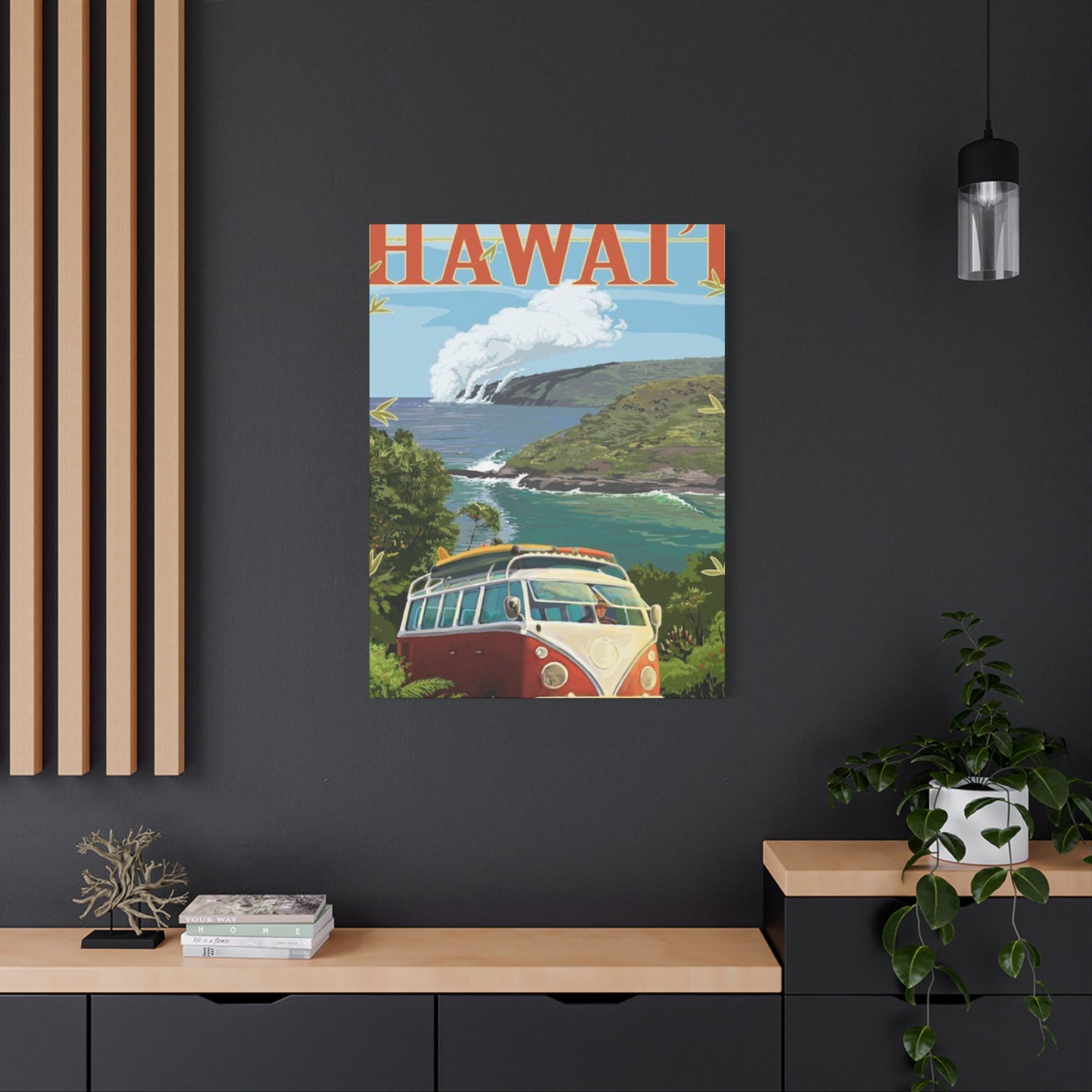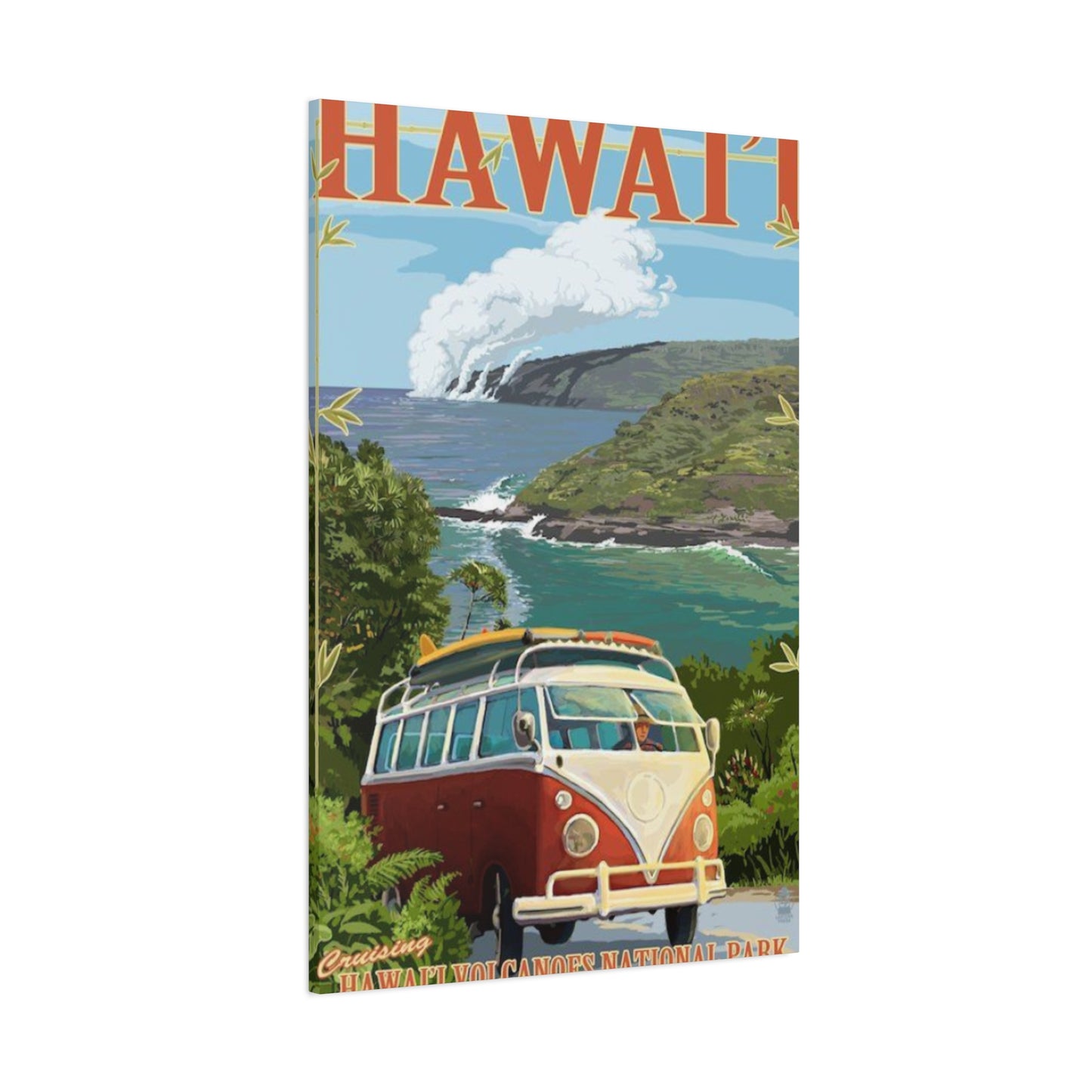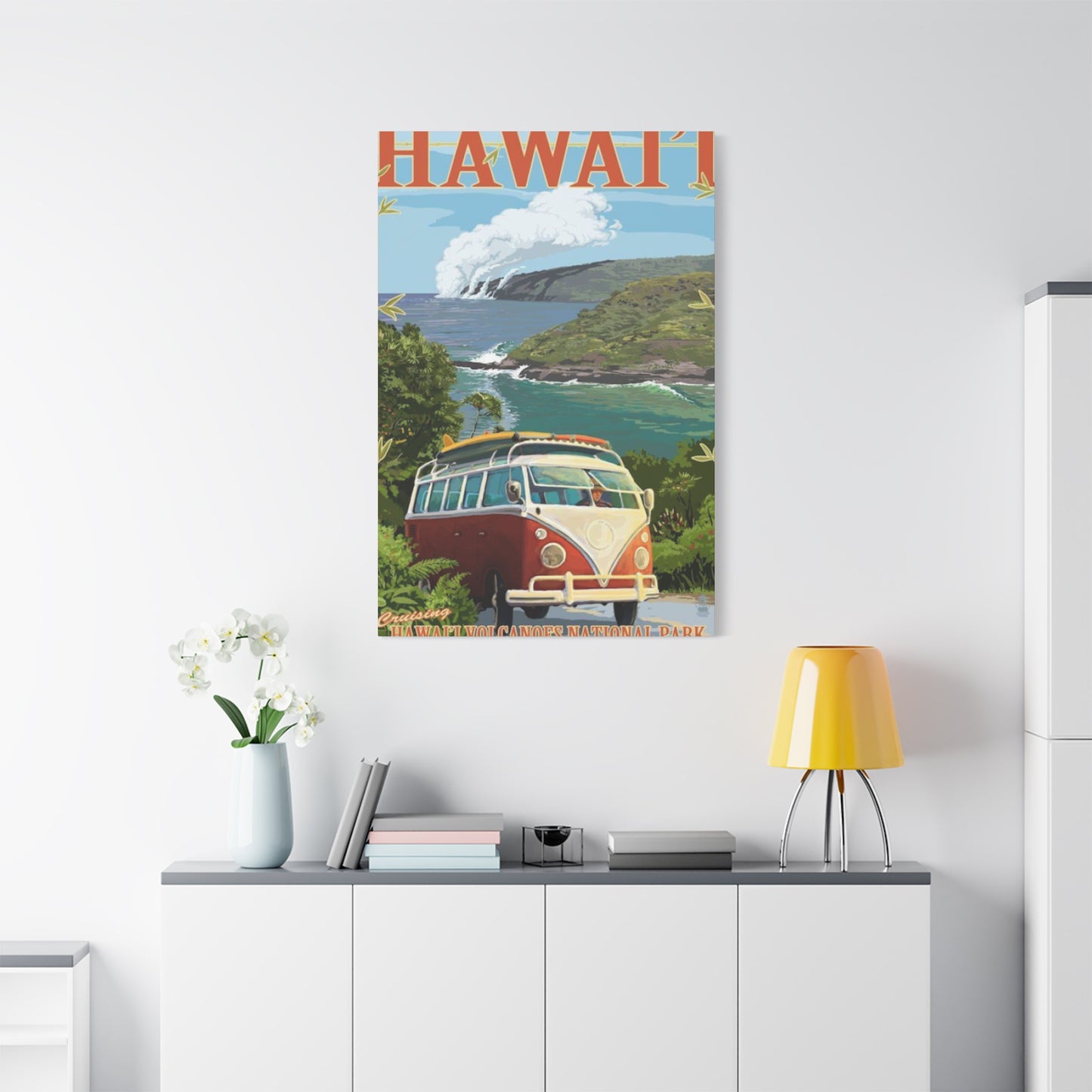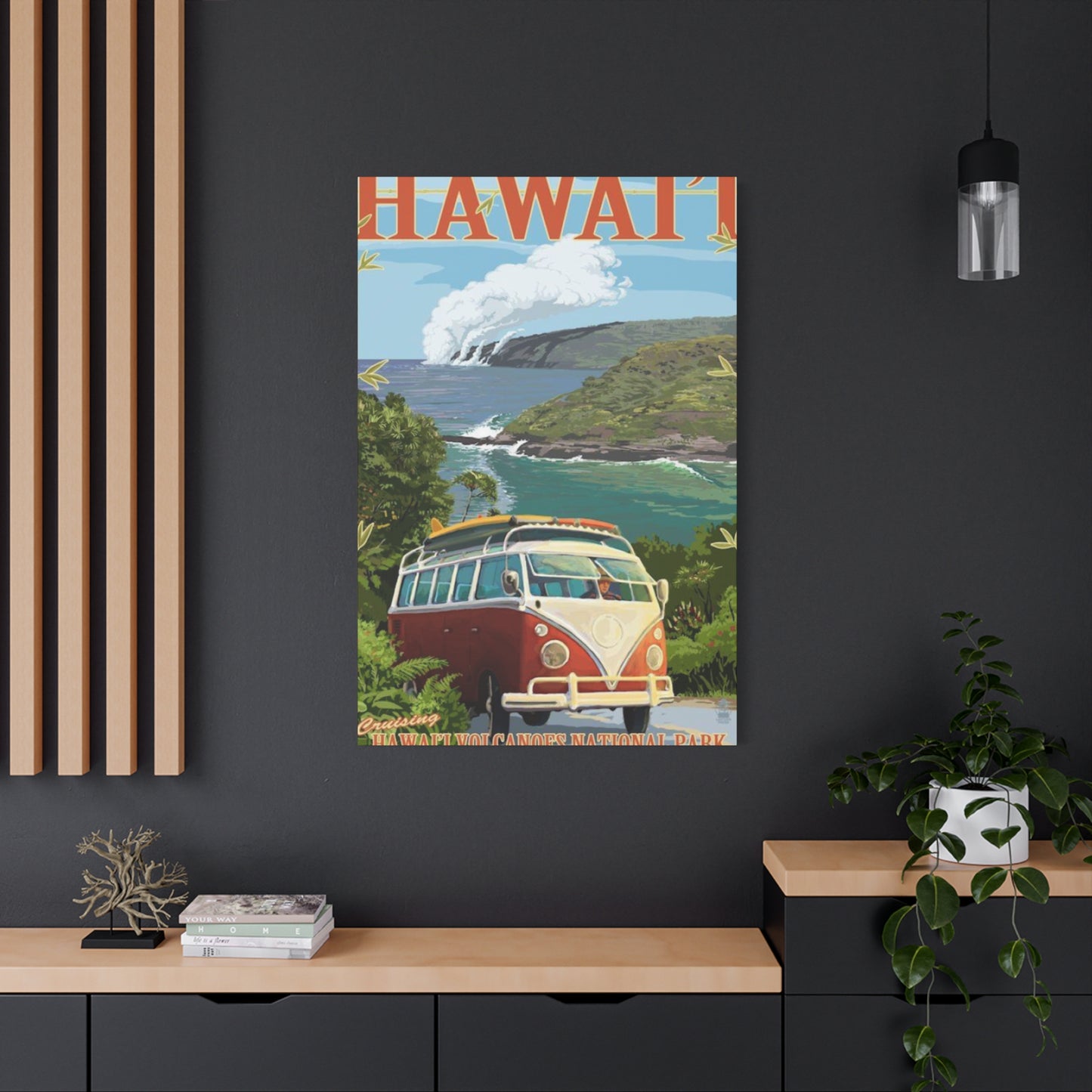Breathtaking Hawaii Volcanoes National Park Wall Art Collections
Hawaii Volcanoes National Park represents one of Earth's most spectacular geological wonders, where molten rock creates breathtaking landscapes that have captivated artists and nature enthusiasts for generations. The dramatic volcanic formations, flowing lava streams, and otherworldly terrains provide endless inspiration for artistic expression. These magnificent natural phenomena have been transformed into stunning visual artwork that brings the raw power and beauty of Hawaiian volcanoes directly into living environments.
The artistic interpretation of volcanic landscapes encompasses various mediums, from traditional oil paintings to modern digital prints, each capturing unique aspects of these geological marvels. Artists have long been drawn to the contrasting elements found within volcanic regions - the destructive force of molten rock alongside the creation of new land, the fiery reds and oranges of lava against the deep blues of ocean waters, and the stark black volcanic rock formations against vibrant tropical vegetation.
Contemporary artists working with volcanic themes often focus on the emotional impact these landscapes create, utilizing color palettes that reflect both the intensity and serenity found within these natural settings. The interplay between light and shadow across volcanic terrain provides rich opportunities for artistic exploration, whether through realistic depictions or abstract interpretations that capture the essence rather than literal representation.
Museums and galleries worldwide showcase volcanic-themed artwork, recognizing the universal appeal of these powerful natural forces. The popularity of such pieces extends beyond mere aesthetic appreciation, often representing deeper connections to Earth's primal energies and the ongoing process of planetary formation that continues to shape our world.
Masterful Techniques for Capturing Lava Flow in Volcano Wall Art
Creating compelling lava flow artwork requires understanding both the scientific aspects of volcanic activity and the artistic techniques needed to convey movement, heat, and energy on static surfaces. Artists employ various methods to represent the flowing nature of molten rock, from traditional brushwork that follows the natural curves and patterns of lava streams to innovative digital techniques that can simulate the glowing intensity of superheated material.
The challenge in depicting lava flows lies in capturing their dynamic nature while maintaining visual coherence within the overall composition. Successful volcanic artwork often employs techniques such as graduated color transitions that move from intense yellows and whites at the hottest points to deep reds and blacks as the temperature decreases. This temperature gradient creates visual depth and helps viewers understand the three-dimensional nature of flowing lava.
Texture plays a crucial role in lava flow artwork, with artists using various techniques to represent different types of volcanic flows. Pahoehoe lava, with its smooth, rope-like formations, requires different artistic approaches than the rough, chunky textures of aa lava. Mixed media techniques often prove particularly effective for volcanic artwork, allowing artists to combine traditional painting methods with textural elements that add physical dimension to the piece.
Digital artists working with lava flow themes have unique opportunities to create dynamic representations through layered compositions and lighting effects that can simulate the actual glow of molten rock. These technological approaches allow for precise control over color intensity and the creation of effects that might be difficult to achieve through traditional media alone.
The timing aspect of lava flows presents another artistic consideration, as these geological events occur over extended periods with constantly changing characteristics. Artists must decide whether to capture a specific moment in time or attempt to convey the ongoing nature of volcanic activity through compositional elements that suggest continued movement and change.
Strategic Approaches for Selecting Volcanoes National Park Art
Choosing appropriate volcanic-themed artwork requires consideration of multiple factors, including the intended placement, existing decor elements, and personal preferences regarding artistic style and subject matter representation. The selection process should begin with an assessment of the physical environment where the artwork will be displayed, taking into account factors such as lighting conditions, wall dimensions, and surrounding furnishings that will influence how the piece integrates with the overall aesthetic.
Color coordination represents a critical aspect of volcanic art selection, as these pieces often feature intense, dramatic color palettes that can either complement or clash with existing room elements. Understanding the emotional impact of different color combinations helps ensure that the chosen artwork enhances rather than overwhelms the surrounding environment. Warm tones commonly found in volcanic art can create inviting, energetic atmospheres, while cooler interpretations might contribute to more contemplative or sophisticated ambiances.
The scale of volcanic artwork should correspond appropriately to both the physical dimensions of the display area and the visual weight of surrounding elements. Large-scale volcanic pieces can serve as dramatic focal points in spacious areas, while smaller works might be more suitable for intimate settings or as part of grouped arrangements. The intensity of volcanic imagery also influences appropriate sizing, as highly dramatic pieces might require more visual breathing room to avoid overwhelming viewers.
Artistic style preferences play significant roles in volcanic art selection, with options ranging from photorealistic representations that document actual geological features to highly stylized interpretations that emphasize emotional or spiritual connections to volcanic energy. Understanding personal preferences regarding abstraction versus realism helps narrow selection criteria and ensures long-term satisfaction with chosen pieces.
Authentication and quality considerations become particularly important when selecting volcanic-themed artwork, especially for pieces marketed as representing specific locations or geological events. Researching artist credentials, understanding printing processes for reproductions, and verifying the accuracy of geographical representations helps ensure that selected pieces meet both aesthetic and informational expectations.
Volcanic Artwork Designed for Nature Enthusiasts
Nature lovers drawn to volcanic imagery often seek artwork that accurately represents the ecological complexity and geological significance of volcanic environments while maintaining strong aesthetic appeal. These individuals typically appreciate pieces that demonstrate understanding of volcanic processes, native flora and fauna, and the interconnected relationships between geological activity and biological systems found within volcanic regions.
Educational value often enhances the appeal of volcanic artwork for nature enthusiasts, with pieces that incorporate accurate geological details or showcase the unique ecosystems that develop around volcanic activity. Artists who combine scientific knowledge with artistic skill create works that satisfy both aesthetic desires and intellectual curiosity, making these pieces particularly valuable for viewers who appreciate learning through visual experience.
The seasonal variations found in volcanic environments provide rich subject matter for nature-focused artwork, from the stark beauty of dormant volcanic landscapes to the explosive drama of active eruptions. Understanding these natural cycles helps artists create works that resonate with viewers who have personal experience with volcanic regions or strong interests in geological processes.
Conservation themes often appear in volcanic artwork intended for nature enthusiasts, highlighting the importance of protecting these unique environments while showcasing their inherent beauty and scientific significance. Such pieces can serve dual purposes as aesthetic enhancements and educational tools that promote environmental awareness and appreciation for geological heritage.
Endemic species representations add biological interest to volcanic artwork, showcasing the unique plants and animals that have adapted to volcanic environments over thousands of years. These biological elements help viewers understand the complete ecological picture of volcanic regions while adding visual variety and interest to predominantly geological subject matter.
Exploring Abstract versus Realistic Volcano Paintings
The artistic interpretation of volcanic subjects spans a broad spectrum from highly realistic documentary-style representations to completely abstract expressions that capture emotional or spiritual responses to volcanic energy rather than literal visual details. Understanding the differences between these approaches helps viewers select artwork that aligns with their aesthetic preferences and intended use for the pieces.
Realistic volcanic artwork focuses on accurate representation of geological features, color relationships, and spatial relationships found in actual volcanic landscapes. These pieces often require extensive research and direct observation, with artists studying photographic references or visiting volcanic sites to ensure accuracy in their representations. The appeal of realistic volcanic art lies in its ability to transport viewers to actual locations and provide educational insights into geological processes.
Abstract volcanic interpretations prioritize emotional impact and artistic expression over literal representation, using volcanic themes as starting points for exploring color relationships, compositional dynamics, and symbolic content. These pieces might focus on the energy patterns associated with volcanic activity, the psychological impact of geological forces, or the spiritual significance attributed to volcanic phenomena in various cultures.
Semi-abstract approaches combine elements of both realistic and abstract techniques, maintaining recognizable volcanic features while incorporating interpretive elements that enhance emotional impact or artistic interest. These hybrid styles often prove popular with viewers who appreciate both accuracy and creative interpretation, providing familiar subject matter presented through unique artistic perspectives.
The choice between abstract and realistic approaches often depends on the intended function of the artwork within its display environment. Realistic pieces might be more appropriate for educational settings or locations where geographical accuracy enhances the overall experience, while abstract interpretations might better serve purely aesthetic functions or contribute to contemplative atmospheres.
Color usage represents a primary differentiating factor between abstract and realistic volcanic artwork, with realistic pieces constrained by actual color relationships found in nature while abstract works have complete freedom to explore color combinations that serve artistic or emotional purposes rather than documentary accuracy.
Professional Framing Techniques for Volcanic Artwork
Proper framing significantly enhances the presentation and longevity of volcanic-themed artwork while providing opportunities to integrate pieces more effectively with their display environments. The intense colors and dramatic subject matter typical of volcanic art require careful consideration of framing materials and techniques that complement rather than compete with the artwork itself.
Color selection for framing materials should take into account the dominant tones present in volcanic artwork while considering the surrounding decor elements that will influence the overall visual impact. Neutral tones often work well with volcanic art because they allow the intense colors within the artwork to remain the primary focus, while metallic frames can add sophistication and help integrate pieces into contemporary settings.
Matting techniques provide opportunities to create visual separation between the artwork and its frame while adding depth and sophistication to the overall presentation. The width and color of matting materials can significantly influence how volcanic artwork appears within its frame, with wider mats generally creating more formal presentations while narrower mats maintain focus on the artwork itself.
UV protection becomes particularly important for volcanic artwork, especially for pieces featuring bright colors that might fade over time when exposed to direct sunlight. Quality framing materials include UV-filtering glass or acrylic that helps preserve color integrity while maintaining visual clarity. This protection proves especially valuable for original paintings or limited-edition prints that represent significant investments.
Conservation framing techniques ensure that valuable volcanic artwork receives appropriate protection from environmental factors that could cause deterioration over time. These methods include using acid-free materials, creating proper ventilation behind the artwork, and selecting hanging systems that distribute weight evenly to prevent stress-related damage.
Reliable Sources for Hawaii Volcanoes National Park Prints
Locating high-quality prints of Hawaii Volcanoes National Park requires research into reputable sources that offer authentic representations created by skilled photographers and artists with direct experience of these remarkable landscapes. The popularity of volcanic imagery has created a market filled with varying quality levels, making careful source selection essential for obtaining pieces that meet aesthetic and technical standards.
Official park services often provide access to authorized prints created by professional photographers who have received permits for commercial photography within protected volcanic areas. These sources typically ensure both quality and accuracy while contributing to conservation efforts through licensing fees that support park maintenance and protection programs.
Gallery representatives specializing in Hawaiian or volcanic-themed artwork usually maintain relationships with established artists and photographers who focus on these subjects. These professional connections often provide access to limited-edition pieces or exclusive works that might not be available through general retail channels. Gallery professionals can also provide valuable guidance regarding authenticity and investment potential for significant purchases.
Online marketplaces offer extensive selections of volcanic prints, but require careful evaluation of seller credentials and product specifications to ensure quality and authenticity. Reading customer reviews, examining return policies, and verifying printing specifications help identify reliable sources among the numerous options available through internet commerce.
Art fairs and exhibitions focusing on Hawaiian culture or geological themes provide opportunities to meet artists directly and examine artwork in person before making purchasing decisions. These venues often feature established artists alongside emerging talents, offering diverse options at various price points while providing opportunities for direct artist interaction and potential custom commission arrangements.
Museum shops associated with natural history institutions or geological organizations frequently offer carefully curated selections of volcanic-themed prints that combine aesthetic appeal with educational accuracy. These sources typically maintain high standards for both artistic quality and scientific accuracy, making them reliable options for purchasers who value both beauty and authenticity.
Cultural Influences in Hawaiian Volcano Artwork
Hawaiian volcanic artwork draws deep inspiration from indigenous cultural traditions that view volcanic activity as manifestations of powerful spiritual forces, particularly Pele, the goddess of volcanoes and fire in Hawaiian mythology. Understanding these cultural connections enhances appreciation for artwork that incorporates traditional Hawaiian perspectives on volcanic phenomena while respecting the sacred nature of these geological features within indigenous belief systems.
Traditional Hawaiian artistic motifs often appear in contemporary volcanic artwork, including patterns derived from lava formations, colors associated with volcanic activity in cultural traditions, and symbolic representations that connect geological processes with spiritual beliefs. These cultural elements add layers of meaning beyond mere aesthetic appeal, creating artwork that honors both natural beauty and cultural heritage.
The concept of mana, or spiritual energy, frequently influences artistic interpretations of Hawaiian volcanoes, with artists attempting to capture not only the visual aspects of volcanic activity but also the spiritual power attributed to these forces within Hawaiian culture. This approach creates artwork that resonates on multiple levels, appealing to viewers interested in both natural beauty and cultural significance.
Contemporary Hawaiian artists often blend traditional cultural perspectives with modern artistic techniques, creating volcanic artwork that maintains cultural authenticity while appealing to diverse contemporary audiences. This fusion approach helps preserve cultural traditions while making them accessible to people who might not have direct connections to Hawaiian heritage.
Respect for indigenous perspectives becomes crucial when selecting or creating volcanic artwork that incorporates Hawaiian cultural elements, ensuring that sacred symbols and beliefs receive appropriate treatment rather than superficial appropriation. Understanding the cultural context behind artistic choices helps viewers develop deeper appreciation for pieces that honor both natural beauty and cultural significance.
Effective Integration of Volcanic Artwork in Living Environments
Incorporating volcanic-themed artwork into residential settings requires careful consideration of how these often dramatic pieces will function within daily living environments while maintaining their visual impact and thematic coherence. The intense energy typically associated with volcanic imagery can create powerful focal points when properly integrated with existing design elements and spatial relationships.
Room function influences appropriate selection and placement of volcanic artwork, with pieces chosen for private areas potentially differing from those suitable for public entertaining areas. The emotional impact of volcanic imagery should complement the intended use of each environment, whether creating energetic atmospheres that encourage activity or contemplative settings that promote relaxation and reflection.
Lighting considerations prove particularly important for volcanic artwork because these pieces often rely on color intensity and contrast to achieve their visual impact. Natural lighting conditions throughout different times of day can dramatically affect how volcanic artwork appears, while artificial lighting options provide opportunities to enhance specific aspects of pieces through strategic illumination techniques.
Scale relationships between volcanic artwork and surrounding furnishings require careful planning to ensure appropriate visual balance within each environment. Large-scale volcanic pieces can dominate smaller areas while potentially appearing lost in expansive settings, making proper sizing crucial for achieving intended aesthetic effects.
Color coordination strategies help integrate volcanic artwork with existing decor elements while maintaining the integrity of both the artwork and the surrounding design scheme. Understanding how the warm tones typically found in volcanic art interact with different color palettes enables successful integration that enhances rather than conflicts with existing aesthetic choices.
Volcanic Artwork Perfect for Living Room Environments
Living rooms provide ideal settings for volcanic artwork because these central gathering areas can accommodate the dramatic visual impact typically associated with volcanic imagery while allowing multiple viewers to appreciate pieces during social interactions. The formal yet comfortable nature of most living room environments complements the majesty and power conveyed through quality volcanic artwork.
Conversational opportunities arise naturally when volcanic artwork serves as focal points in living areas, with pieces providing talking points that can lead to discussions about travel experiences, geological interests, or artistic preferences. This social aspect adds functional value beyond mere aesthetic enhancement, making volcanic artwork particularly suitable for environments designed for entertaining and social interaction.
Seasonal flexibility represents another advantage of volcanic artwork in living areas, as these pieces typically maintain visual interest throughout the year without requiring seasonal adjustments or modifications. The timeless nature of geological subjects ensures long-term aesthetic relevance that justifies investment in quality pieces for primary living areas.
Furniture arrangement considerations become important when incorporating volcanic artwork into living room designs, with seating arrangements potentially requiring adjustment to ensure optimal viewing angles for significant pieces. The visual weight of volcanic artwork should be balanced through thoughtful placement of other design elements to create harmonious overall compositions.
Multiple viewing distances in living rooms allow appreciation of different aspects within volcanic artwork, from detailed examination of artistic techniques at close range to overall compositional impact when viewed from across the room. This flexibility enhances the long-term enjoyment potential of carefully selected pieces while providing varied aesthetic experiences within the same environment.
Adventure-Themed Volcanic Art Collections
Adventure enthusiasts drawn to volcanic imagery often seek artwork that captures the excitement, challenge, and natural wonder associated with exploring active geological regions. These individuals typically appreciate pieces that convey the physical and emotional experiences of volcanic encounters while celebrating the courage and curiosity required for such adventures.
Expedition documentation through artistic representation appeals to adventure-minded collectors who value artwork that tells stories about human interaction with powerful natural forces. These pieces often incorporate elements that suggest the scale and intensity of volcanic environments while highlighting the small but significant presence of human explorers within these vast landscapes.
Technical accuracy in adventure-themed volcanic artwork often holds particular importance for enthusiasts who have personal experience with volcanic regions and can recognize authentic details versus romanticized interpretations. Artists working in this genre benefit from direct experience or extensive research to ensure their work resonates with knowledgeable audiences who value both aesthetic appeal and factual accuracy.
Equipment and preparation themes sometimes appear in adventure-focused volcanic artwork, showcasing the specialized gear and careful planning required for safe exploration of active volcanic areas. These elements add educational value while celebrating the technical aspects of volcanic adventure that appeal to serious outdoor enthusiasts.
Personal challenge narratives often influence adventure-themed volcanic artwork, with pieces exploring themes of human determination, natural humility, and the personal growth that can result from encounters with powerful geological forces. These psychological elements add depth to adventure-focused collections while appealing to viewers who understand the transformative potential of challenging outdoor experiences.
Monochromatic Volcanic Landscape Presentations
Black and white interpretations of volcanic landscapes offer unique aesthetic opportunities that emphasize form, texture, and compositional elements while removing the distraction of color relationships that often dominate volcanic imagery. This monochromatic approach can create sophisticated artistic statements that focus attention on fundamental design elements rather than the dramatic color relationships typically associated with volcanic subjects.
Contrast manipulation becomes a primary artistic tool in monochromatic volcanic artwork, with artists using the full range from pure white to deep black to create visual hierarchy and emphasize important compositional elements. The natural contrast found in volcanic landscapes, from bright steam and clouds to dark rock formations, provides excellent source material for effective black and white interpretations.
Textural emphasis receives enhanced attention in monochromatic volcanic artwork because viewers focus more closely on surface variations and pattern relationships when color information is removed. The rough textures of volcanic rock, the smooth flows of solidified lava, and the soft gradations of volcanic gases all become more prominent in black and white presentations.
Historical photographic traditions influence contemporary black and white volcanic artwork, with artists often drawing inspiration from master photographers who documented volcanic activity before color photography became widely available. This historical connection adds gravitas and artistic legitimacy to contemporary monochromatic interpretations while honoring established artistic traditions.
Modern minimalist aesthetics often favor monochromatic volcanic artwork because these pieces can provide visual interest and natural subject matter while maintaining the clean, uncluttered appearance preferred in contemporary design schemes. Black and white volcanic art offers dramatic subject matter without the visual complexity that colored versions might contribute to minimalist environments.
Canvas-Based Volcanic Landscape Artworks
Canvas presentations of volcanic landscapes provide traditional artistic foundations that enhance the classical appeal of geological subject matter while offering durability and versatility advantages over alternative presentation methods. The texture and visual weight of canvas materials complement the natural, earthy themes typically associated with volcanic artwork while providing surfaces that can accommodate various artistic techniques and media applications.
Oil painting traditions find natural expression through volcanic landscape subjects on canvas, with the slow-drying characteristics of oil paints allowing artists to blend colors and create textural effects that effectively represent the complex visual qualities found in volcanic environments. The richness and depth achievable through oil techniques particularly suit the dramatic lighting and intense color relationships characteristic of volcanic subjects.
Acrylic painting applications on canvas offer faster-working alternatives to oil techniques while maintaining excellent color saturation and textural possibilities suited to volcanic landscape representation. The quick-drying nature of acrylic paints enables layering techniques that can effectively represent the complex geological formations and atmospheric effects found in volcanic regions.
Mixed media approaches on canvas provide opportunities to incorporate textural elements that enhance the tactile qualities associated with volcanic landscapes, using materials such as sand, pumice, or metallic elements to create physical texture that complements visual representations. These techniques can add authenticity and sensory appeal to volcanic artwork while creating unique pieces that cannot be easily reproduced.
Stretching and mounting considerations for canvas-based volcanic artwork require attention to proper tension and support systems that maintain flat presentation while accommodating the visual weight and scale typical of volcanic landscape paintings. Professional mounting techniques ensure long-term stability while preserving the artistic integrity of significant pieces.
Professional Environment Volcanic Artwork Applications
Office environments can benefit significantly from carefully selected volcanic artwork that provides visual interest and conversation opportunities while maintaining professional appropriateness and contributing to positive workplace atmospheres. The natural grandeur and scientific interest associated with volcanic subjects can enhance professional settings without creating inappropriate distractions or conflicting with business-focused activities.
Motivational themes naturally associated with volcanic imagery, such as power, transformation, and natural forces overcoming obstacles, can provide subtle psychological benefits in work environments where productivity and achievement represent important goals. The elemental nature of volcanic subjects can remind viewers of fundamental forces and long-term perspectives that help maintain focus during challenging professional situations.
Color psychology considerations become particularly important when selecting volcanic artwork for professional environments, as the intense reds and oranges commonly found in volcanic imagery can create energetic atmospheres that either enhance or overwhelm work-focused activities. Understanding how different color combinations affect mood and productivity helps ensure that volcanic artwork contributes positively to professional environments.
Scale appropriateness for office settings typically favors medium-sized volcanic pieces that provide visual interest without dominating work areas or creating distractions during important business activities. The dramatic nature of volcanic subjects requires careful sizing to ensure appropriate visual impact that enhances rather than overwhelms professional atmospheres.
Cultural sensitivity becomes important when selecting volcanic artwork for diverse professional environments, ensuring that chosen pieces respect different cultural perspectives on natural phenomena while avoiding imagery that might be considered inappropriate or distracting by colleagues from various backgrounds.
Innovative Mixed Media Volcanic Art Concepts
Mixed media approaches to volcanic art creation offer unlimited creative possibilities for artists seeking to capture the complex sensory experiences associated with volcanic environments through combinations of traditional and unconventional materials. These techniques allow artists to incorporate actual volcanic materials, textural elements, and innovative presentation methods that create unique artistic statements impossible to achieve through single-medium approaches.
Textural incorporation using actual volcanic materials such as pumice, lava rock, or volcanic sand can add authenticity and tactile interest to mixed media volcanic artwork while creating direct physical connections between viewers and the geological processes being represented. These material choices require careful consideration of adhesion methods and long-term stability to ensure professional presentation and durability.
Layering techniques in mixed media volcanic art can effectively represent the geological stratification and temporal processes associated with volcanic activity, using different materials to represent various geological periods or eruption events within single artistic compositions. These approaches can create educational value alongside aesthetic appeal while demonstrating artistic understanding of geological processes.
Lighting integration possibilities in mixed media volcanic artwork include fiber optic elements, LED systems, or reflective materials that can simulate the glowing characteristics of active volcanic activity while creating dynamic presentations that change based on viewing conditions or time of day. These technological enhancements can create engaging interactive experiences that capture viewer attention and maintain long-term interest.
Dimensional elements in mixed media volcanic art can extend beyond traditional flat presentations to create sculptural qualities that better represent the three-dimensional nature of volcanic landscapes while providing multiple viewing perspectives that reveal different aspects of the artistic composition as viewers move around the piece.
Travel Memento Volcanic Art Collections
Volcanic artwork serves as meaningful travel souvenirs that provide lasting connections to extraordinary geological destinations while offering aesthetic value that enhances living environments long after travel experiences have concluded. These pieces can evoke powerful memories and emotional connections to specific locations while serving as conversation starters that allow travelers to share their experiences with others.
Authenticity considerations become particularly important when selecting volcanic artwork as travel mementos, with pieces created by local artists or featuring location-specific geological features providing more meaningful connections to travel experiences than generic volcanic imagery that could represent any location. Researching artist credentials and geographical accuracy helps ensure that selected pieces maintain authentic connections to visited destinations.
Documentation value of travel-related volcanic artwork can enhance personal travel archives while providing educational opportunities for family members and friends who may not have direct experience with volcanic environments. These pieces can serve as focal points for sharing travel stories and geological knowledge while maintaining visual reminders of extraordinary natural experiences.
Investment potential exists for carefully selected volcanic artwork acquired during travel, particularly pieces created by established local artists or featuring unique geological phenomena specific to particular destinations. Understanding local art markets and artist reputations can help travelers make selections that provide both immediate satisfaction and potential long-term value appreciation.
Shipping and transportation considerations require planning when acquiring volcanic artwork during travel, with size, weight, and fragility factors influencing practical selection decisions. Understanding international shipping requirements and customs procedures helps ensure that desired pieces can be successfully transported to permanent display locations.
Thoughtful Volcanic Art Gift Selections
Volcanic artwork makes distinctive gift choices that demonstrate thoughtfulness and appreciation for recipients' interests in natural phenomena, adventure, or unique artistic subjects. The dramatic beauty and universal appeal of volcanic imagery can create memorable gifts that provide long-term enjoyment while reflecting the giver's attention to recipient preferences and interests.
Recipient interest assessment becomes crucial when selecting volcanic artwork as gifts, considering factors such as existing decor preferences, available display areas, and personal connections to geological subjects or specific volcanic destinations. Understanding these preferences helps ensure that selected pieces will be appreciated and appropriately utilized rather than stored or ignored.
Personalization opportunities in volcanic artwork gifts might include pieces representing destinations with special significance to recipients, custom framing that coordinates with their existing decor, or artist selections that align with their aesthetic preferences. These personal touches demonstrate extra consideration while increasing the likelihood that gifts will be valued and displayed prominently.
Educational components can enhance the gift value of volcanic artwork, particularly for recipients interested in geological sciences or natural phenomena. Pieces accompanied by information about the geological processes, cultural significance, or artistic techniques represented can provide learning opportunities that extend beyond mere aesthetic appreciation.
Presentation considerations for volcanic artwork gifts include professional packaging that protects pieces during transportation while creating impressive unboxing experiences that enhance the perceived value and thoughtfulness of the gift. Quality presentation materials demonstrate respect for both the artwork and the recipient while ensuring safe delivery of potentially fragile items.
Large-Format Volcanic Art Installations
Large-scale volcanic artwork creates powerful visual statements that can transform entire environments while providing immersive experiences that effectively convey the magnitude and drama associated with volcanic phenomena. These significant pieces require careful planning regarding placement, lighting, and environmental integration to achieve maximum impact while maintaining appropriate proportional relationships with surrounding elements.
Architectural integration considerations become crucial when installing large volcanic artwork, with pieces potentially requiring structural modifications or specialized mounting systems that can safely support substantial weight while providing secure long-term installation. Professional consultation may be necessary to ensure proper installation techniques that protect both the artwork and the surrounding structure.
Viewing distance planning for large volcanic artwork helps optimize the visual experience while ensuring that pieces can be appreciated from multiple perspectives within their display environments. Understanding how compositional elements appear from various distances enables strategic placement that maximizes aesthetic impact while maintaining functional use of surrounding areas.
Lighting design for large volcanic artwork requires sophisticated planning to ensure even illumination across substantial surface areas while avoiding glare or hot spots that could detract from the viewing experience. Professional lighting consultation can help develop systems that enhance color accuracy and visual impact while providing appropriate illumination levels for the intended environment.
Maintenance requirements for large volcanic artwork installations include regular cleaning procedures, environmental monitoring to prevent damage from temperature or humidity fluctuations, and periodic professional conservation services to ensure long-term preservation of significant investments in major artistic pieces.
Flora and Fauna Integration in Volcanic Artwork
The unique ecosystems that develop around volcanic environments provide rich opportunities for artistic exploration that combines geological drama with biological diversity, creating complex compositions that celebrate both the destructive and creative aspects of volcanic activity. These integrated approaches can appeal to viewers interested in complete ecological representations rather than purely geological subjects.
Endemic species representation in volcanic artwork showcases the remarkable adaptations that allow plants and animals to thrive in challenging volcanic environments, from heat-resistant plants that colonize fresh lava flows to specialized wildlife that takes advantage of unique habitat opportunities created by volcanic activity. These biological elements add scientific interest while demonstrating the resilience and adaptability of life.
Seasonal variations in volcanic ecosystems provide diverse subject matter opportunities for artists seeking to represent the dynamic changes that occur as volcanic landscapes mature and develop complex biological communities over time. Understanding these ecological succession processes can inform artistic choices that accurately represent different stages of ecosystem development.
Conservation messaging often emerges naturally in volcanic artwork that includes flora and fauna elements, highlighting the importance of protecting unique volcanic ecosystems that support specialized species found nowhere else on Earth. These conservation themes can add depth and purpose to artistic work while educating viewers about environmental challenges facing volcanic regions.
Scientific accuracy considerations become particularly important when incorporating biological elements into volcanic artwork, as viewers interested in natural history may recognize inaccuracies that could detract from the overall credibility and appeal of artistic pieces. Research and consultation with biological experts can help ensure appropriate species representation and ecological relationships.
Professional Volcanic Photography for Wall Display
High-quality photographic prints of volcanic landscapes offer documentary accuracy combined with artistic composition, providing viewers with authentic representations of extraordinary geological phenomena while maintaining the aesthetic appeal necessary for successful wall display applications. Professional volcanic photography requires specialized skills, equipment, and often dangerous working conditions that contribute to the value and uniqueness of resulting images.
Technical expertise requirements for volcanic photography include understanding of extreme lighting conditions, heat-resistant equipment capabilities, and safety protocols necessary for working near active volcanic features. Professional photographers specializing in volcanic subjects typically possess extensive experience and specialized equipment that enables them to capture images impossible for casual photographers to obtain.
Composition principles in volcanic photography must balance documentary accuracy with aesthetic appeal, using traditional photographic techniques such as rule of thirds, leading lines, and depth of field manipulation to create visually engaging images that also accurately represent geological features and processes. Understanding both photographic art and geological science enhances the quality of resulting images.
Print quality considerations for volcanic photography wall displays include color accuracy, resolution requirements for various display sizes, and paper or canvas choices that complement the subject matter while providing appropriate longevity for permanent display applications. Professional printing services specializing in fine art reproduction can ensure optimal results for significant photographic pieces.
Limited edition considerations in volcanic photography can enhance investment value while ensuring exclusivity for collectors interested in unique pieces that won't be widely reproduced. Understanding edition sizes, authenticity certification, and artist reputation helps evaluate the long-term value potential of photographic volcanic artwork.
Rustic Environment Volcanic Art Integration
Rustic design environments provide natural settings for volcanic artwork that can complement existing natural materials and earth-toned color palettes while adding dramatic focal points that enhance the connection to natural phenomena. The elemental nature of both rustic design philosophy and volcanic subject matter creates harmonious relationships that feel authentic and appropriate.
Material coordination between volcanic artwork and rustic furnishings often involves natural materials such as wood, stone, and metal that echo the geological themes present in volcanic imagery while maintaining consistent aesthetic approaches throughout the environment. Understanding how different natural materials interact visually helps create cohesive design schemes that feel organic rather than forced.
Color palette considerations in rustic environments typically favor earth tones and natural colors that coordinate well with the warm reds, oranges, and browns commonly found in volcanic artwork while maintaining the subdued, comfortable atmosphere characteristic of rustic design approaches. Balancing dramatic volcanic colors with rustic restraint requires careful selection and placement strategies.
Lighting approaches in rustic environments often emphasize warm, soft illumination that complements both the relaxed atmosphere of rustic design and the dramatic nature of volcanic artwork. Natural lighting sources such as fireplaces or warm LED systems can enhance the cozy appeal of rustic settings while providing appropriate illumination for volcanic art display.
Authenticity maintenance becomes important when integrating volcanic artwork into rustic environments, ensuring that selected pieces maintain the honest, unpretentious qualities valued in rustic design while avoiding overly sophisticated or commercial presentations that might conflict with the natural, understated aesthetic preferred in rustic settings.
Aloha Spirit Expression Through Volcanic Art
The Hawaiian concept of Aloha encompasses more than simple greeting or farewell, representing a comprehensive philosophy of living that emphasizes love, peace, compassion, and harmony with natural forces. Volcanic artwork that embodies these principles can provide visual representations of this spiritual approach while honoring the cultural context within which Hawaiian volcanoes hold sacred significance.
Cultural respect becomes paramount when creating or selecting volcanic artwork intended to represent Aloha spirit, ensuring that sacred symbols, traditional meanings, and indigenous perspectives receive appropriate treatment rather than superficial appropriation. Understanding Hawaiian cultural values and their relationship to volcanic phenomena helps create authentic artistic expressions that honor both natural beauty and cultural heritage.
Spiritual connection themes often appear in Aloha-inspired volcanic artwork, reflecting the Hawaiian understanding of volcanoes as manifestations of divine forces that deserve respect and reverence rather than mere aesthetic appreciation. These spiritual elements can add depth and meaning to volcanic art collections while promoting cross-cultural understanding and respect.
Harmony principles central to Aloha philosophy can influence artistic choices regarding color relationships, compositional balance, and thematic integration within volcanic artwork intended to reflect these cultural values. Understanding how Hawaiian culture perceives balance and harmony in natural relationships can inform artistic decisions that create authentic cultural expressions.
Contemporary interpretation challenges arise when attempting to express traditional Aloha concepts through modern artistic media and presentation methods, requiring artists to balance cultural authenticity with contemporary aesthetic expectations while maintaining respect for indigenous traditions and beliefs.
Seasonal Themes in Volcanic Art Collections
Seasonal variations in volcanic environments provide diverse artistic opportunities that can reflect changing weather patterns, tourist cycles, and natural phenomena that occur throughout the year in volcanic regions. Understanding these seasonal differences allows artists and collectors to create diverse collections that maintain visual interest while accurately representing the full range of experiences available in volcanic environments.
Weather pattern influences on volcanic landscapes create dramatically different aesthetic opportunities throughout the year, from clear conditions that reveal detailed geological features to storm systems that add dramatic atmospheric elements to volcanic compositions. These weather variations can inspire diverse artistic interpretations that showcase different moods and characteristics of the same volcanic locations.
Tourist season considerations might influence artistic representations of volcanic destinations, with pieces potentially reflecting either the busy energy of peak visitation periods or the serene solitude available during quieter times of year. Understanding these tourism patterns can help artists create works that appeal to different audience preferences regarding crowded versus pristine natural experiences.
Ecological changes throughout the year in volcanic regions provide opportunities for artistic exploration of how plant and animal communities respond to seasonal variations in temperature, rainfall, and daylight patterns. These biological changes can add temporal interest to volcanic artwork while demonstrating the dynamic nature of volcanic ecosystems.
Cultural calendar connections in Hawaiian and other volcanic regions often associate specific times of year with traditional ceremonies, festivals, or cultural practices that might influence artistic interpretations of volcanic landscapes. Understanding these cultural associations can add depth and authenticity to seasonal volcanic artwork while respecting indigenous traditions and contemporary cultural practices.
Conclusion
The world of volcanic wall art represents a fascinating intersection of natural wonder, artistic expression, and cultural significance that offers collectors and art enthusiasts endless opportunities for exploration and appreciation. From the raw power captured in lava flow representations to the sophisticated cultural interpretations that honor Hawaiian traditions, volcanic artwork provides unique aesthetic experiences that can transform living and working environments while connecting viewers to some of Earth's most spectacular geological phenomena.
The diversity of artistic approaches available in volcanic art ensures that every preference and setting can find appropriate pieces, whether through realistic photographic documentation that captures scientific accuracy, abstract interpretations that emphasize emotional impact, or mixed media innovations that incorporate actual volcanic materials for authentic tactile experiences. This artistic variety reflects the complex nature of volcanic environments themselves, where destructive forces create new land, intense heat generates stunning visual displays, and unique ecosystems develop in challenging conditions.
Professional considerations surrounding volcanic art acquisition, from understanding proper framing techniques to evaluating artist credentials and print quality, help ensure that investments in these dramatic pieces provide long-term satisfaction and appropriate value retention. The specialized nature of volcanic subject matter requires attention to authenticity, cultural sensitivity, and scientific accuracy that goes beyond typical art purchasing decisions, making education and research essential components of successful collecting strategies.
The integration possibilities for volcanic artwork span numerous environments and applications, from intimate residential settings where these pieces can serve as conversation starters and sources of daily inspiration, to professional environments where the themes of natural power and transformation can provide subtle motivational influences. Understanding how volcanic art functions in different contexts helps optimize selection and placement decisions while maximizing the aesthetic and psychological benefits these pieces can provide.
Cultural appreciation emerges as a crucial element in volcanic art engagement, particularly when dealing with Hawaiian volcanic imagery that carries deep spiritual significance within indigenous traditions. Respecting these cultural connections while appreciating the universal appeal of volcanic beauty creates opportunities for cross-cultural understanding and meaningful artistic experiences that honor both natural phenomena and human cultural heritage.
The future of volcanic art continues to evolve through technological innovations, changing artistic techniques, and growing environmental awareness that influences how artists and collectors approach these geological subjects. Mixed media possibilities, digital enhancement techniques, and new printing technologies provide

















